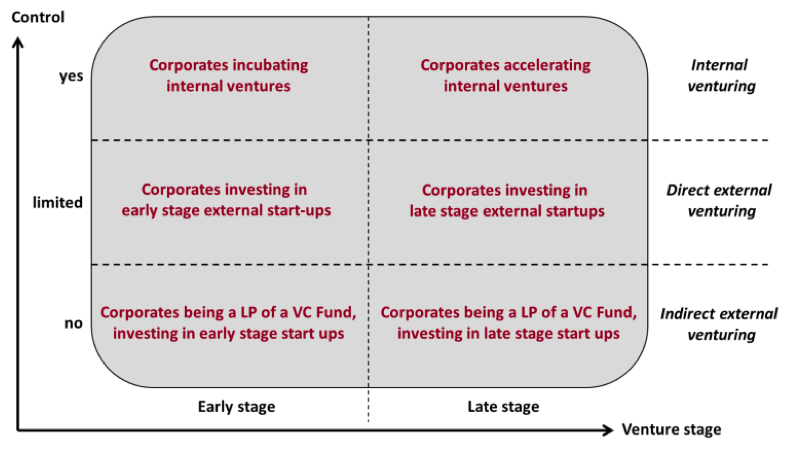Our New Book:
Released on March 6 2015 at ASML at the 50th
meeting of the Corporate Venturing Network Netherlands. Corporate venturing almost sounds like a ‘contradictio in terminis’ (a combination of words whose meanings are in conflict with one another). Ventures are generally seen as small, agile and entrepreneurial…
Corporate Venturing
Managing the innovation family in a dynamic world
Corina Kuiper and Fred van Ommen
- Corporate venturing almost sounds like a ‘contradictio in terminis’ (a combination of words whose meanings are in conflict with one another). Ventures are generally seen as small, agile and entrepreneurial, whereas corporates are seen colossal, slow and inflexible. In addition the ventures want to use new business models, target new customers and use new channels that are often on bad terms or even conflicting with the current business models, market and go-to-market approach of the large corporates. In fact startups often look at corporates as the dinosaurs that want to kill them. It’s no secret that many successful companies struggle to grow beyond their core offering. This is not because organizations can’t identify new opportunities or develop new and novel concepts; many can and actually do. However, companies often have problems launching these new concepts. Internal politics, risk avoidance, and the fear of failure weigh heavily on these new business initiatives. It’s easy to underestimate just how much inertia the core business has within a company; the entire organization has evolved around its success.
- This book describes why and how corporates can successfully apply the different tools of venturing to create new business that is crucial for their long term survival. The book contains and overview of methods and tool how companies can reinvent themselves. It shows how Corporate Venturing is a full member of the innovative family, where infants and adolescents are the new business initiatives and the parents and grandparents represent the existing business, including the tensions that exist between the adolescent and his parents. How do you create an environment in which a parent to your children protected on the one hand but on the other hand also get every opportunity to develop into successful individuals?
- This book takes you behind the scenes of fifteen very different innovation families, members of Corporate Venture Network Netherlands ( www.cvnn.eu ) , namely: Asahi Glass Company, ASML, Bekaert, Brightlands Chemelot Campus, Dutch Polymer Institute, Royal DSM, Fujifilm, KLM Royal Dutch Airlines, Océ Canon, Port of Rotterdam Authority, Sibelco, Sioux, Solvay, TNO and Vision Dynamics.
- Corporate venturing does not stand on its own but is/should be an integral part of the innovation portfolio of a company. There are different types of innovations and a ‘one size fits all’ approach doesn’t work. One needs to distinguish between the different family members with in the ‘innovation family’ as each member (innovation type) requires its own set-up, way of working, and measurements.
- Corporate venturing is a concept, which is hard to define. Not only companies but also (corporate) venturing studies use many different definitions. Some people use a very narrow definition and confine it to a specific unit or function that is managing a corporate venture fund. Others define corporate venturing as ‘all of the entrepreneurial activities aimed at setting-up new businesses within or in close cooperation with a large corporate organization’. Furthermore, terms like ‘incubator’ and ‘accelerator’ are not only frequently used interchangeable but also can have several different and sometimes ambivalent meanings. This brings about a veritable tower of Babel in corporate venturing. The objective of this paragraph is to create an overview of the different flavors of corporate venturing.
- To characterize ventures one can look at the degree of control that a corporate has and the maturity or age of the venture. In this way we can distinguish 6 different types of corporate venturing shown, distinguishing between early and late stage ventures and between internal venturing and external venturing by investing in startups or VC funds.

The success of corporate depends not only on the venture itself but on the ventures total environment and context. This is shown in figure 3. Showing the 5 levels that determine the success of corporate venturing:

Each level has its own criteria, which are described in the book. One of the most intriguing elements is the role of the entrepreneur. One of the scientific approaches describing entrepreneurship is ‘Effectuation’, 5 simple principles which describe how entrepreneurs take decisions in uncertainty.
All of these elements are used in the description of corporate venturing of the 15 member companies and a number of leading global companies. It is clear that there are different approaches are possible and necessary and the book gives advice for both growing children and parents. The book makes clear that there are different approaches are possible and necessary. It contains advice for both growing children and parents and shows that corporate venturing has become a vital force and innovation instrument.
